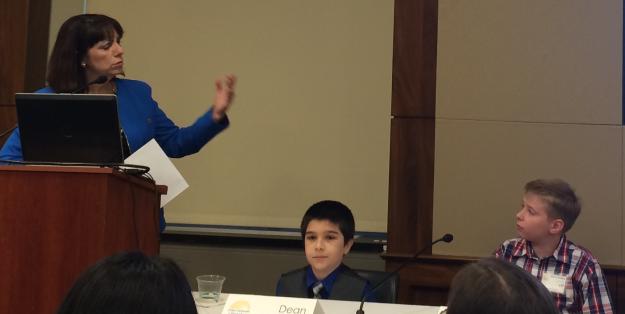Teachers warming to videos, games in the classroom — report

Teachers are starting to figure something out: Kids love videos and games.
According to a new report from education nonprofit Project Tomorrow that tracks the use of online content in schools, 68 percent of teachers surveyed said they used videos in their classroom in 2015, versus 47 percent in 2012.
And more than three-quarters of middle school students are tapping into online videos, and six out of 10 students are playing online educational games, according to the report, “From Print to Pixel: The role of videos, games, animations and simulations within K-12 education.”
“We need a different type of learning experience to prepare students for the future,” Julie Evans, CEO of Project Tomorrow, said at a briefing on Capitol Hill on Thursday.
Evans added that alternatives to written materials can help achieve this goal, since the brain processes visuals about 60 times faster than text.
Other findings from the report include:
- Simulations are more widely used by teachers in virtual classes (23 percent) and teachers who have implemented a flipped learning model (26 percent) or a blended learning model (17 percent).
- School principals (84 percent) are almost unanimous in their belief that the effective use of technology within instruction is important for student success.
- Almost 60 percent of technology leaders say one-quarter of instructional materials in their schools today are digital, not paper-based.
- The top subject areas in which the students in grades 6-12 watch videos to support homework, research projects or studying are science (66 percent), math (59 percent), social studies/history (53 percent) and English/language arts (45 percent).
A panel of teachers and students assembled at the briefing shared their experiences using videos and games in their classes.
Beth Megonigal, a chemistry teacher in Calvert County Public Schools, Maryland, said she assigns videos that are about two to five minutes long to teach concepts like collision theory.
“There has been a huge change at my school — in 12 years, we’ve gone from having a few computer labs to laptop carts that we can take in the classroom,” she said. “And now we have Wi-Fi in school, which is huge.”
From Calvert County to Fairfax County to Frederick County, other teachers said their schools are either in the process of “going one-to-one” — giving each student a device — or implementing a “bring your own device program,” or using a flipped classroom model.
“We use a flipped learning model, and [the students] get the lecture at home, and I’ve noticed that they feel more confident when they come into the classroom with some background information,” said Beth Panicucci, who said she teaches mostly English language learners.
Amy Dodson, a middle school history teacher in Frederick County Public Schools in Maryland, said she uses EDpuzzle, a video platform, “because it allows me to input questions and add my notes or voice to give additional instruction.”
The platform is also linked to Google Classrooms, and Dodson added that she can easily grade assignments online.
For their part, kids on the panel said they love the videos as well, and often watch them several times to absorb the content.
Videos “help me learn a little quicker, and I can understand it better if I watch it more than once,” said seventh-grader Ben.
But, according to the report, 57 percent of principals say the lack of teacher training on how to integrate digital content was the biggest barrier to expanding online learning.
Mary Catherine Keating, a high school history teacher in Fairfax County Public Schools in Virginia, said she works with “paleo” teachers who cut out screens altogether in their classrooms.
Keating said it’s important to get these teachers “started with the discussion” about technology because “this is not the classroom I went into anymore.”
Reach the reporter at corinne.lestch@edscoop.com and follow her on Twitter @clestch and @edscoop_news.




